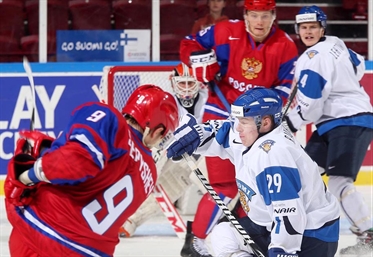Home is where the medals are
Home is where the medals are
Finland looks to offence, home ice

 Preliminary-round action at the Hartwall Arena includes host Finland and last year’s silver medallist Russia. Also Slovakia, the Czech Republic and Belarus play in the group. Photo: Andre Ringuette / HHOF-IIHF Images
Preliminary-round action at the Hartwall Arena includes host Finland and last year’s silver medallist Russia. Also Slovakia, the Czech Republic and Belarus play in the group. Photo: Andre Ringuette / HHOF-IIHF Images
The last time around, in 2004, coach Hannu Aravirta, then fresh off his job as the head coach of the men’s team, took a fairly mediocre team to a bronze medal. Only Valtteri Filppula and Sean Bergenheim went on to have a meaningful NHL career.
That tournament was played in the old Helsinki arena, built in 1966, at a time in which it was enough to call it Helsinki Jäähalli, which is “ice rink” in Finnish.
In the previous tournament that Finland hosted, in 1998, the expectations were higher thanks to the return of one particular player, Olli Jokinen.
Jokinen had played eight games in the NHL in the fall, returned to Helsinki, played for IFK, and was the big leader the team needed. That tournament was played in the then-new Hartwall Areena, and a capacity crowd witnessed Finland’s win over Russia in the final.
All in all, Finland has won 13 medals (3 gold, 4 silver, 6 bronze) in the 39 previous official IIHF World Junior Championships, a third of the time. Finland has hosted the tournament five times (1980, 1985, 1990, 1998 and 2004) and has never finished lower than fourth, winning the gold medal once, and getting one silver and one bronze.
Finland won another bronze in 2006, but then went without medals until 2014 when Teuvo Teräväinen and Rasmus Ristolainen led the team all the way to gold.
This year, there is reason for optimism in Finland again.
The team’s goalies, Veini Vehvilainen and Kaapo Kahkonen have shown in the Finnish Liiga that they’re elite goaltenders. Vehvilainen has posted the league’s second-best goals against average (1.79) and save percentage (93.82) in 15 games for JYP Jyvaskyla while Kahkonen’s numbers are just behind Vehvilainen’s (2.26 and 92.06) in 14 games with Espoo Blues that has had a tumultuous season amid financial problems.
But somewhat surprisingly, the team’s biggest strength may lie in its offence.
Sebastian Aho scored the Liiga championship-winning goal last season and has this season scored almost a point a game. Patrik Laine and Jesse Puljujarvi are expected to go early in next summer’s NHL draft. Laine leads all rookies in scoring, followed by Sebastian Repo.
In addition, Finland gets Kasperi Kapanen and Mikko Rantanen from the AHL. Rantanen was Finland’s big hero in last year’s tournament when he led the team in goal scoring with four, and was the only Finn to score more than once in the tournament.
For Kapanen, last year’s World Juniors was the second disappointing outing in a row, after the under-18 tournament (also on home ice), but this time around, it is a more mature and relaxed forward that takes the ice on Boxing Day.
“Of course there is pressure when we play at home and people expect me to play well. Last year, Twitter overheated as the Finns vented their emotions there. I’ll just try to be one of guys on the team and get the most out of myself,” Kapanen told Yle recently.
He is older now and he’s got half a season in the AHL behind him. He knows he’s on his way to the NHL and can just focus on his game.
Finland had beat Russia both times the teams have met this season, and it is Russia that they will have to beat in the group to win it. An interesting forward to keep an eye on is Metallurg Novokuznetsk’s 18-year-old Kirill Kaprizov, the Minnesota Wild’s fifth-round pick last summer, who’s scored nine goals and 23 points in 41 games, third on his team.
And then there’s Maxim Tretiak, the grandson of the Soviet legend Vladislav, who is also the head of the Russian Ice Hockey Federation. Whether he can grab the starting job remains to be seen.
Goalies are always the most important players on the team, but that may hold even more true for the Czech and Slovak teams. A hot goalie can take his team on a real Cinderella story ride.
“The most important match is the quarter-final. There, we have to grab it,” says Vitek Vanecek, who was on the Czech team last year but didn’t play the quarter-final game against Slovakia. This season, the 19-year-old Washington Capitals second-round pick from 2014 has played for the South Carolina Stingrays in the ECHL.
Slovakia was the Cinderella team last season, winning bronze, thanks to magnificent goaltending by Denis Golda, who was voted tournament MVP. This season, he has played in Finland’s second-tier Mestis, and it’s up to a new generation to pick up the torch.
For Belarus, the tournament is all about avoiding relegation. Only three players returned from the team that won the Division I Group A tournament last year but the team will be eager to surprise fans and opponents alike.
Back to Overview
















































